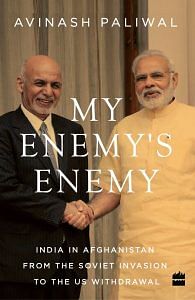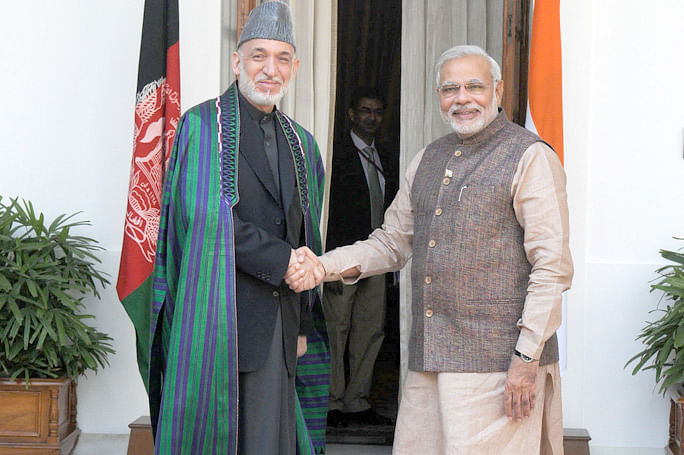Irrespective of which group dominated Indian policy, India rarely appears to have got its way in Afghanistan.
There is a paradox about Indian power. Even as it seeks a larger global role – witness Prime Minister Modi’s Davos excursion, or the continuing search for a permanent seat in the UN Security Council – New Delhi seems unable to manage its own neighbourhood. And it is not because India lacks power – it represents about three-quarters of the GDP of the region, to cite only one data point. But India has demonstrated a unique incapacity not only to be the normative and political leader of the region but even to ensure that it can consistently defend its core security interests in the region.
Nothing illustrates this incapacity more vividly than Afghanistan. It is vitally important to India because if it is controlled by Pakistan’s proxies – think of the Taliban in the latter half of the 1990s – the territory could become a base for terrorism against India and embolden Pakistan to engage in misadventures against India in the belief it now has “strategic depth”. So it is no surprise that New Delhi has spent considerable amount of effort and treasure on the country. What is surprising, however, is how little India has achieved for all this. Indeed, India is routinely left out of even important international confabulations on Afghanistan. Pakistan, despite near universal recognition of its complicity in Afghanistan’s troubles, its partisan and barely disguised support for the Taliban, and its extensive use of terrorist groups such as the Haqqani network, remains the key determinant of peace. How is this possible? Why has India failed so completely in advancing its interests in the country?
Avinash Paliwal’s excellent, detailed and readable account of India’s Afghan policy focuses on internal policy deliberations among Indian decision-makers about how to address the changing equations in Afghanistan. He suggests two broad camps within the government of India: the ‘conciliators’ and the ‘partisans’, which appears to broadly correspond to the normally used categories in foreign policy debates, the idealists and the realists, respectively. Their disagreement was about the tactics by which Pakistan’s influence in Afghanistan could be reduced. The conciliators wanted to reach out to all groups in Afghanistan, which included, over the last decade, sections of the Taliban. The partisans, however, wanted to counter Pakistan by supporting any anti-Pakistan group or through covert action against Pakistan directly, especially in collaboration with the Afghan secret service. The conciliators dominated Indian policy under the second UPA government but the partisans have regained some lost ground in the recent past, Paliwal suggests.
But irrespective of which group dominated Indian policy, India rarely appears to have got its way in Afghanistan. Paliwal himself appears to favour the conciliator’s point of view but the assumptions behind it are questionable. There may be factions of the Taliban that are willing to talk to New Delhi, but none have shown much willingness to go beyond this, if only because Pakistan has dealt brutally with those who have stepped out of line. India has not shown the same kind of single-mindedness in dealing with friends and foes, and the conciliator’s attempt to reach out to all groups has only confused India’s old partners and made it untrustworthy to potential new ones.
Paliwal’s account also suggests that India paid inordinate attention to the concerns of other actors, including the US, limiting India’s pursuit of its own interests. This left India twisting in the wind each time the US changed its own approach to Afghanistan. New Delhi had already abandoned its United Front/Northern Alliance partners and its pursuit of the Pashtun option did not go far either, leaving it without too many options. On the other hand, it is difficult to imagine how India expected to advance its interests with unrealistic and fantastical objectives such as wanting an ‘Afghan-led, Afghan-owned reconciliation without external interference’. This is the loser’s cry, and there can be no greater indication of India’s failures than this pathetic plea.
But what his narrative also demonstrates is that despite what appears to have been a very active debate within the Indian security bureaucracy, the government does not appear to have devoted the kind of effort and resources to building either broad-based support across all sections, or support within specific anti-Pakistan group, except during the period when the Taliban was in control, when India devoted some measure of support to the United Front/Northern Alliance. India has built dams and highways and other infrastructure projects, but it is clear that this has helped India little in advancing its core security interests in the country, even if it garnered some amount of Afghan popular support. India does take some pride in this, but Afghanistan is a particularly difficult terrain for ‘soft power’ to have much traction.
It is impossible to do justice to Paliwal’s rich narrative, which is based on extensive interviews with Indian security officials and participants from all sides of this little game, declassified archival materials and WiKileaks documents, in addition to the usual secondary sources. Paliwal’s sourcing is both fascinating but, in its extensive use of interviews, also a wee bit troubling because recollections can always be uncertain and sometimes even self-serving. On the other hand, for scholars researching contemporary foreign policy issues, this is also probably unavoidable. This quibble notwithstanding, Paliwal’s book is undoubtedly a worthy addition to the growing but still small list of rich histories of India’s diplomacy and strategy.
Dr. Rajesh Rajagopalan is a professor of International Politics in Jawaharlal Nehru University, New Delhi.
 ‘My Enemy’s Enemy: India In Afghanistan from the Soviet Invasion to the US Withdrawal, by Avinash Paliwal’ has been published by Harper Collins.
‘My Enemy’s Enemy: India In Afghanistan from the Soviet Invasion to the US Withdrawal, by Avinash Paliwal’ has been published by Harper Collins.



